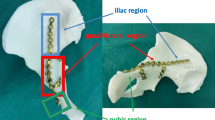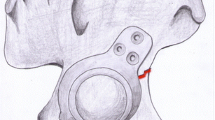Abstract
Purpose
This study aims to compare the effectiveness of anatomic locking plate and reconstruction plate used in treating acetabular fractures.
Methods
From January 2009 to January 2016, patients with acetabular fractures were included in this retrospective study. We grouped the patients into two groups based on the internal fixation: reconstruction plate group (RPG) and anatomic locking plate group (ALPG). The operation time, blood loss, intra-operative screw penetration, and plate breakage were compared between the two groups. The intra-operative fluoroscopic images were used to evaluate the fixation location. The quality of reduction and radiological grading were assessed according to the criteria developed by Matta. The clinical assessment was based on the Merle d’Aubigne-Postel score.
Results
Eighty-three patients were included in this study and were followed up for an average of 35 months (range, 25 to 42 months). Thirty-five patients were treated with the anatomical locking plate, and 48 patients were treated with the reconstruction plate. The mean surgical time was significantly shorter (P < 0.0001) in ALPG patients than in RPG patients, and the intra-operative blood loss was significantly lower (P = 0.008). The rates of intra-operative screw penetration or plate breakage in the ALPG (0/35) are significantly lower than that in the RPG (7/48) (P = 0.018). Post-operative Matta score (P = 0.905), Merle d’Aubigne-Postel score (P = 0.957), and overall complication rates (P = 0.391) were not significantly different among the groups.
Conclusion
Patients treated by anatomical locking plate had shorter operation time, less bleeding, and lower rate screw perforation compared to patients treated by reconstruction plate. Anatomical locking plate is a better choice for acetabulum fractures, especially complicated fractures.




Similar content being viewed by others
Availability of data and materials
Data and materials relating to the study were accessed from the case systems at our department.
References
Guerado E, Cano JR, Cruz E (2012) Fractures of the acetabulum in elderly patients: an update. Injury 43(Suppl 2):S33–S41. https://doi.org/10.1016/s0020-1383(13)70177-3
Baschera D, Rad H, Collopy D, Zellweger R (2015) Incidence and clinical relevance of heterotopic ossification after internal fixation of acetabular fractures: retrospective cohort and case control study. J Orthop Surg Res 10:60. https://doi.org/10.1186/s13018-015-0202-z
Giannoudis PV, Grotz MR, Papakostidis C, Dinopoulos H (2005) Operative treatment of displaced fractures of the acetabulum. A meta-analysis. J Bone Joint Surg (Br) 87(1):2–9
Matta JM (1996) Fractures of the acetabulum: accuracy of reduction and clinical results in patients managed operatively within three weeks after the injury. J Bone Joint Surg Am 78(11):1632–1645
Zhang Q, Chen W, Wu X, Yanling S, Hou Z, Zhang Y (2014) Comparative study of W-shaped angular plate and reconstruction plate in treating posterior wall fractures of the acetabulum. PLoS One 9(3):e92210. https://doi.org/10.1371/journal.pone.0092210
Anizar-Faizi A, Hisam A, Sudhagar KP, Moganadass M, Suresh C (2014) Outcome of Surgical Treatment for Displaced Acetabular Fractures. Malays Orthop J 8(3):1–6. https://doi.org/10.5704/moj.1411.001
Ebraheim NA, Savolaine ER, Hoeflinger MJ, Jackson WT (1989) Radiological diagnosis of screw penetration of the hip joint in acetabular reconstruction.J. Orthop Traumatol 3(3):196–201. https://doi.org/10.1097/00005131-198909000-00003
Anglen JO, DiPasquale T (1994) The reliability of detecting screw penetration of the acetabulum by intraoperative auscultation (1994). J Orthop Trauma 8(5):404–408. https://doi.org/10.1097/00005131-199410000-00006
Carmack DB, Moed BR, McCarroll K (2001) Accuracy of detecting screw penetration of the acetabulum with intraoperative fluoroscopy and computed tomography. J Bone Joint Surg Am 83 A(9):1370–1375. https://doi.org/10.2106/00004623-200109000-00012
Xu M, Zhang L-H, Zhang Y-Z, He C-Q, Zhang L-C, Wang Y, Tang P-F (2013) Development of Site-specific locking Plates for Acetabular Fractures. Orthopaedics 36(5):593–600. https://doi.org/10.3928/01477447-20130426-21
Xu M, Zhang L-H, Zhang Y-Z, Zhang L-C, He C-Q, Wang Y, Tang P-F (2014) Custom-made Locked Plating for Acetabular Fracture: A Pilot Study in 24 Consecutive Cases. Orthopaedics 37(7):660–669. https://doi.org/10.3928/01477447-20140626-59
Letournel E (1980) Acetabulum fractures: classification and management. Clin Orthop Relat Res (151):81–106
Norris BL, Hahn DH, Bosse MJ, Kellam JF, Sims SH (1999) Intraoperative fluoroscopy to evaluate fracture reduction and hardware placement during acetabular surgery. J Orthop Trauma 13(6):414–417. https://doi.org/10.1097/00005131-199908000-00004
Ochs BG, Marintschev I, Hoyer H, Rolauffs B, Culemann U, Pohlemann T, Stuby FM (2010) Changes in the treatment of acetabular fractures over 15 years: analysis of 1266 cases treated by the German Pelvic Multicentre Study Group (DAO/DGU). Injury 41(8):839–851. https://doi.org/10.1016/j.injury.2010.04.010
Murphy D, Kaliszer M, Rice J, McElwain JP (2003) Outcome after acetabular fracture: prognostic factors and their inter-relationships. Injury 34(7):512–517. https://doi.org/10.1016/s0020-1383(02)00349-2
Shazar N, Eshed I, Ackshota N, Hershkovich O, Khazanov A, Herman A (2014) Comparison of acetabular fracture reduction quality by the ilioinguinal or the anterior intrapelvic (modified Rives–Stoppa) surgical approaches. J Orthop Trauma 28(6):313–319. https://doi.org/10.1097/01.bot.0000435627.56658.53
Liu X, Xu S, Zhang C, Jiacan S, Yu B (2010) Application of a shape-memory alloy internal fixator for treatment of acetabular fractures with a follow-up of two to nine years in China. Int Orthop 34(7):1033–1040. https://doi.org/10.1007/s00264-009-0867-1
Ferguson TA, Patel R, Bhandari M, Matta JM (2010) Fractures of the acetabu1um in patients aged 60 years and older:an epidemiological and radiological study. J Bone Joint Surg (Br) 92(2):250–257. https://doi.org/10.1302/0301-620x.92b2.22488
Cornell CN (2004) Hip fractures in the elderly: on the acetabular side. Orthopedics 27(9):931–932
Pagenkopf E, Grose A, Partal G, Helfet DL (2006) Acetabular fractures in the elderly: treatment recommendations. HSS J 2(2):161–71. https://doi.org/10.1007/s11420-006-9010-7
Abdulla J, Awaiz A, Rees WM (2019) Intra-operative cell salvage in pelvic and acetabular fracture surgery: a retrospective comparative study. Int Orthop 43(7):1695–1699. https://doi.org/10.1007/s00264-018-4104-7
Laird A, Keating JF (2005) Acetabular fractures:a 16-year prospective epidemiological study. J Bone Joint Surg (Br) 87(7):969–973. https://doi.org/10.1302/0301-620x.87b7.16017
Ruipeng Z, Yingchao Y, Ao L, Wang Z, Zhiyong H, Yan Z, Shicai F, Wu Z, Chengla Y, Gang L, Ma X, Yingze Z (2019) Three-Column Classification for Acetabular Fractures: Introduction and Reproducibility Assessment. J Bone Joint Surg Am 101(22):2015–2025. https://doi.org/10.2106/JBJS.19.00284
Amer S, Guillaume R, Mourad Z, Peter U, Véronique M, Pomme J (2018) Standardized three dimensional computerised tomography scanner reconstructions increase the accuracy of acetabular fracture classification. Int Orthop 42(8):1957–1965. https://doi.org/10.1007/s00264-018-3810-5
Fornaro J, Keel M, Harders M, Marincek B, Székely G, Frauenfelder T (2010) An interactive surgical planning tool for acetabular fractures: initial results. J Orthop Surg Res 5:50. https://doi.org/10.1186/1749-799X-5-50
Antell NB, Switzer JA, Schmidt AH (2017) Management of Acetabular Fractures in the Elderly. J Am Acad Orthop Surg 25(8):577–585. https://doi.org/10.5435/jaaos-d-15-00510
Kendoff D, Gardner MJ, Citak M, Kfuri M Jr, Thumes B, Krettek C, Hüfner T (2008) Value of 3D fluoroscopic imaging of acetabular fractures comparison to 2D fluoroscopy and CT imaging. Arch Orthop Trauma Surg 128(6):599–605. https://doi.org/10.1007/s00402-007-0411-y
Stockle U, Schaser K, Konig B (2007) Image guidance in pelvic and acetabular surgery—expectations, success and limitations. Injury 38(4):450–462. https://doi.org/10.1016/j.injury.2007.01.024
Chang JK, Gill SS, Zura RD, Krause WR, Wang GJ (2001) Comparative strength of three methods of fixation of transverse acetabular fractures. Clin Orthop Relat Res 392:433–441. https://doi.org/10.1097/00003086-200111000-00057
Mehin R, Jones B, Zhu Q, Broekhuyse H (2009) A biomechanical study of conventional acetabular internal fracture fixation versus locking plate fixation. Can J Surg 52(3):221–228
Egol KA, Kubiak EN, Fulkerson E, Kummer FJ, Koval KJ (2004) Biomechanics of locked plates and screws. J Orthop Trauma 18(8):488–493. https://doi.org/10.1097/00005131-200409000-00003
Siyu T, Yajie C, Yingchao Y, Ruipeng Z, Zhiyong H, Yingze Z (2019) Morphological Characteristics of Posterior Wall Fragments Associated with Acetabular Both-column Fracture. Sci Rep 9(1):20164. https://doi.org/10.1038/s41598-019-56838-5
Author information
Authors and Affiliations
Contributions
Peifu Tang and Licheng Zhang: contribution to the research design, data acquisition, and revising it critically; Zhijiang Li and Jiantao Li: data acquisition, drafting the paper, and approval of the submitted and final version; Zhirui Li, Shaobo Nie, and Hao Zhang: data acquisition, statistical analysis, and approval of the submitted and final version; Ming Li, Jianheng Liu, Zhongyang Liu, and Gaoxiang Xu: data acquisition and approval of the submitted and final version.
Corresponding authors
Ethics declarations
Ethics approval
The study has been approved by the Ethics Committee of Chinese PLA General Hospital under Grant No. S2020-115-01 and written informed consent was obtained from the patients for the publication of individual clinical details and accompanying images. This research has been conducted according to the ethical principles expressed in the Declaration of Helsinki.
Consent to participate
Written informed consent was obtained from the patients for the publication of individual clinical details and accompanying images.
Consent to publish
Written informed consent was obtained from the patients for the publication of individual clinical details and accompanying images.
Conflict of interest
The authors declare that they have no conflicts of interest.
Additional information
Publisher’s note
Springer Nature remains neutral with regard to jurisdictional claims in published maps and institutional affiliations.
Rights and permissions
About this article
Cite this article
Li, Z., Li, J., Li, Z. et al. Comparative study of anatomical locking plate and reconstruction plate in treating acetabular fractures. International Orthopaedics (SICOT) 45, 2727–2734 (2021). https://doi.org/10.1007/s00264-021-04970-1
Received:
Accepted:
Published:
Issue Date:
DOI: https://doi.org/10.1007/s00264-021-04970-1




